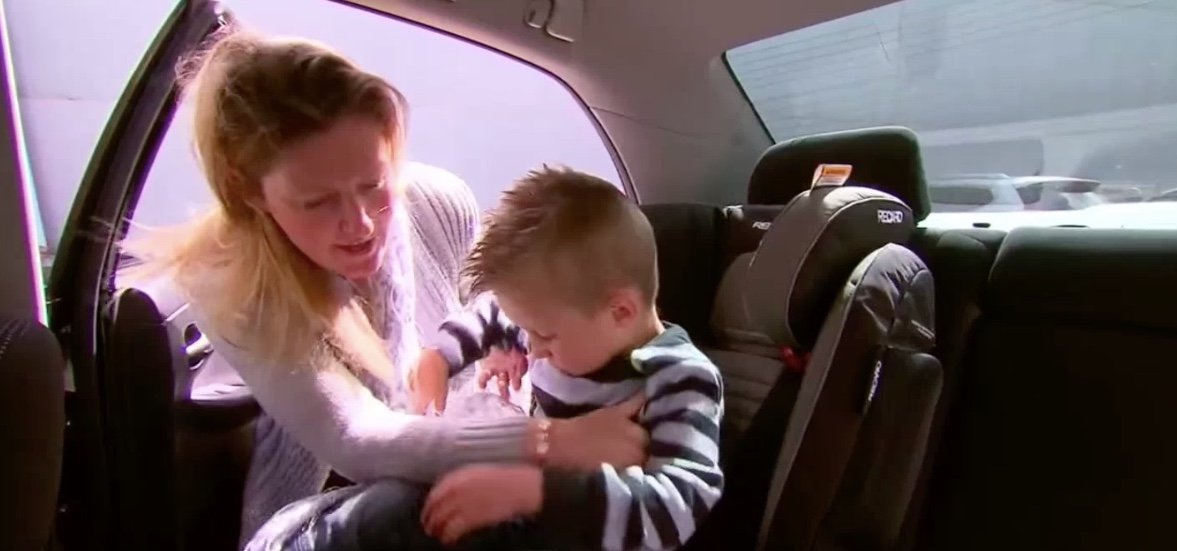#149 - Are Mums with Babies a Driving Hazard?
You know that feeling, right?
When you’ve left a conference feeling buzzed - energetic - inspired - enthusiastic!
You’re itching to get back to work to pencil down your ideas, and start to gather your team together to do some new cool stuff.
I would have to say that there were many positive feelings after the 2017 Pediatric Sleep Meeting in Florida. What we learned. The networking. The laughter and the tears.
Instead - my Long Service Leave had banked up so much I was forced to take a week off after I came back from Florida.
And it was on one of those days during my Long Service Leave that I had …
An ‘AHA’ Moment! (Part One)
I had the pleasure of doing the ‘school runs’ during my week off (aka, driving my son to school in the morning and picking him up in the afternoon). I never usually got to relax and spend time conversing with him like I did during our drives.
One morning, I dropped him off and then decided to get the food shopping done early.
I was driving down Commercial Rd to my old haunt (the Seaford Shopping Centre), when I had to brake a little harder than usual because there was a car that entered the roundabout I was approaching.
Cars never came out from this side street onto this roundabout, so it was a bit of a surprise.
But if you believe in fate, maybe that’s what it was.
Because after I came to a sudden halt, I looked in my rearview mirror - in the hope the car behind me was also going to brake.
And the rearview didn’t look promising.
The car wasn’t slowing down.
Milliseconds turned into seconds as I waited for the impact.
And then that strange screeching sound happened - that doesn’t sound like screeching when you’re in a car.
The car behind me came to a skidding halt. The young woman’s face was hovering over her steering wheel due to the inertia of having to stop so quickly.
100 milliseconds later, the woman’s head whipped around to look behind her.
Not to look behind her car, but in the back seat.
Where a babyseat was fastened.
“Lucky!” was the single word that ran through my head.
We moved on to continue the rest of our day …
An ‘AHA’ Moment (Part Two)
In the mid-afternoon I had picked up my son from school and was hearing about the tales of his day as I was driving home.
We came to the usual hillside stop at the traffic lights, waiting for the light to go green.
Whilst I was listening to his response to my question that started the conversation (“What did you learn today?”), I noticed something that was out of place. Something that made me feel weird. Like I was about to faint or something.
But it had nothing to do with me.
The car in front of me was moving.
Slowly moving backwards.
Rolling down the hill towards me as we were waiting on the hill at the traffic lights.
My eyes widened, and I immediately honked the horn.
Within no time, the car halted. Even jolted …
But a connection was made …
The woman sitting in the driver’s seat whipped her head around.
Not to look at me behind her - but to look in her backseat.
At her child sitting in the babychair.
“Of course!” I exclaimed.
“What?” my son asked.
“I can’t believe we hadn’t thought about this before!”
When we got home, my son repeated the story of his day to my wifey.
And I did something I wasn’t supposed to do that week.
I sat down in front of my iMac and shook hands with my friend named ‘Google Scholar’ …
Sleepy at the Wheel
By 2017 there were a boatload of studies looking at the connections between sleep and driving.
Probably the most well known was a study led by - dare I say - one of my ‘sleep step-brothers’ (aka, a PhD graduate of my own PhD mentor - Professor Leon Lack).
Professor Drew Dawson inferred that getting less than 7 hrs of sleep is like driving above the legal alcohol limit.
But probably the most amount of studies that have been done in the sleepy-driving field have been performed on truck drivers, who are prone to getting Sleep Apnea.
In a nutshell, this research has shown higher risk of driving impairments from a range of humans - especially heavy vehicle drivers … and by ‘heavy’, that is the vehicle being heavy - not the driver … although often times these heavy vehicles are driven by heavy drivers … some who may have sleep apnea.
But those with sleep apnea are not the only humans who feel quite sleepy during the day.
Speaking of humans, let me introduce you to one of my former PhD students …
Dr Meg Pillion
Although Meg didn’t know how to conduct a Zoom call, she was nonetheless doing her PhD investigating the links between apps, parental rules, and motivating teens to put down their phones earlier in the night. And she craved to learn more widely about all things sleep.
She had already looked at whether driving became worse when undergoing Sleep Restriction Therapy for Insomnia during her Honours year.
So the idea I brought to Meg was appealing to her.
Could we unpack and dust off the driving simulator and get mums in the hot seat?
Whilst the answer was ‘Yes’, we didn’t think this through. After all - we were trying to do this at Flinders Uni, who spend a sh#tload of money on marketing - and their Vice Chancellor - instead of having enough support staff.
Trying to get our driving simulator working was sooooo bad, we even entertained buying a used secondhand car and getting mums driving it for real at a (controlled) racetrack.
But then something fortuitous happened at another sleep conference …
WorldSleep 2019
At a sleep conference on the other side of the world, Dr Meg bumps into a Queenslander who had been doing a lot of research into alcohol consumption and driving - Dr Chris (Irwin).
Dr Chris was starting to get into sleep science, and was looking to collaborate with like-minded others. We were looking for someone who could get our driving simulator working. So we invited Chris to Flinders one week, and low and behold, we had a functioning simulator.
Then came …
COVID-19
… which made an impact in 2020. So for a while, our driving simulator gathered dust again. But we believed in this study, and knew we needed to see it through to the end.
Post-COVID academia was challenging - especially at Flinders Uni. Workloads crept higher, as middle managers had brain-shart-ideas that burdened academics and barely impressed upper managers.
In other words - I had no time to run this research study. Enter …
Dr Michal Kahn
If you’re new to WINK, you probably haven’t heard of ‘Meeks’. She’s a machine, and can get a job done. Not only that, but she’s a world expert when it comes to infant sleep.
So mind the pun, but I got outta the driver’s seat and rode shotgun. Meeks was taking over.
And so finally - after 6 rollercoaster years - we published our study investigating …
The driving of mums
What we learned from Dr Chris is that there is a particular ‘measure’ of bad driving. It’s called ‘Lane Deviation’. You can see it for yourself on the roads, for example, when someone in front of you is not driving straight in the lane.
They go a bit left … they correct and get in the middle … they drift right … they’re back in the middle … but go right again …
Dr Chris told us you see this a lot when people are driving and using their mobile phones.
You also see it when people are over the legal alcohol limit and their driving.
You do not see it the day after people have consumed marijuana - I’m looking at you Mr Brown-Nosing Malinauskas.
But I’d hypothesise that you’d see it in …
Bed partners - ranked in order of of income (highest-to-lowest)
The driving of dads
Dad research is scarce, despite their dissemination of misinformation of late.
Dad’s are also not immune to sleep disruption from their baby.
An unpublished, yet unusual research finding, is that dads cite that they are ‘too busy’ to participate in research studies - and the second unusual finding is that they report this via the mums who have a 24-hour 7-day a week job!
One interpretation of our new study is that mums with an infant who doesn’t sleep well, drive similarly to one driving over the legal blood alcohol limit - yet - I would hypothesise that the driving of dads is worse - particularly Huberman Husbands who are too lazy to fact check before opening their mouths at a BBQ.
Conclusions?
The conclusion is pretty simple, and it’s the same message over and over again.
You need consistency across research studies to help make a decision.
Our new study is just a single study. More are needed before this research is converted into legislation.
Law is based on evidence, like science.
It follows that laws are based on the majority of research findings.
Like for example, the South Australian Premier’s new legislation that fines individuals for driving 24-hours after consuming marijuana. There’s this evidence from a 2023 systematic review showing the consistency in findings that support this law too …
Ugh, hang on a minute …. whose bed are you lying in now Malinauskas?
WINK20
I thought I was fast when I approached the Founders of the Swiss-Swedish sleepwear company Dagsmejan. I thought that they may need a sleep scientist to inform them about their PJs for sale. I Zoomed with founder Andreas - and learned that they talked to a bunch of thermal, textile and sleep scientists BEFORE they made their range of PJs.
With 6 weeks to go until that truck-driver-turned-overweight-intruder-who-somehow-climbs-down-chimneys-that-no-one-seems-to-own-anymore … visits … there’s an opportunity to get 20% off PJs, sleep masks, socks and more on Dagsmejan’s online store with this code : WINK20
This time I’m gonna get in before you … (hmm .. hope the wifey ain’t reading this blog …)
p.s. here’s a link to our new driving study.















